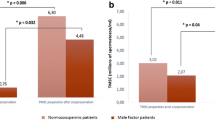Abstract
Objektive: To compare two different spermatozoa preparation mediums, the three-layer Percoll (Sigma, St. Louis, MO; salica-based) and the IxaPrep (Medicult, Copenhagen, Denmark; non-salica based, polysucrose medium) method, with respect to recovery of pregressive motile sperm and various sperm motion characteristics. Analysis was determined by computer-aided sperm analysis and nitric oxide (NO) production of the supernatant after centrifugation. Method: Thirty-nine semen specimens were obtained from men who presented for semen analysis and each of them was divided into two aliquots for preparation with the two mediums mentioned above. The motile sperm recovery, motility percentage and motion parameters were measured for each semen specimen (n=39) before and after preparation using one of the two above methods. The NO was measured using the chemiluminscence method after centrifugation. Results: Recovery rate was higher in the IxaPrep group (Ixaprep: 45.4±28.7% versus Percoll: 32.3±22.7%; p<0.05). The other motion characteristics such as average path velocity (VAP) and straight line velocity (VSL) were better than those of fresh semen samples [VAP: 72±17.2 µm/s (Percoll), 62.8±18.2 µm/s (Ixaprep) vs 52.2±9.5 µm/s (fresh); p<0.05; VSL: 51.8±13.4 µm/s (Percoll), 44.8±12.9 µm/s (Ixaprep) vs 38.6±7.9 µm/s (fresh); p<0.05]. The motility between fresh and post-preparation semen samples had no significant difference. Hyperactivation of the sperm was improved in the IxaPrep group compared with fresh sperm (Percoll: 24.7±16.9% and IxaPrep: 20.5±10.5% versus fresh: 9.2±9.2%; p<0.05). NO produced in the IxaPrep method was significantly lower than that in the Percoll method (Ixaprep: 0.24±0.3 µM versus Percoll: 0.54±0.91 µM; p<0.05). Conclusion: Our data suggests that the IxaPrep method provides a better recovery rate, but that other motion characteristics did not demonstrate any significant difference. The lower level of NO produced in the IxaPrep preparation method may suggest that better sperm quality achieved is due to the decreased NO production.
Similar content being viewed by others
Author information
Authors and Affiliations
Additional information
Received: 2 April 2001 / Accepted: 10 July 2001
Rights and permissions
About this article
Cite this article
Ding, DC., Huang, YC., Liu, JY. et al. Comparison of nitric oxide production and motion characteristics after 3-layer percoll and IxaPrep preparation methods of human sperm. Arch Gynecol Obstet 266, 210–213 (2002). https://doi.org/10.1007/s004040100230
Issue Date:
DOI: https://doi.org/10.1007/s004040100230




